|
Plant Protection
Diseases
Of the several maladies that confront coconut production in Kerala State, the coconut
root (wilt) disease is of utmost concern. The palm is also affected by a number
of other diseases like stem bleeding, bud rot, mahali, leaf rot, gray blight and
Tanjavur wilt.
- Root (wilt) disease
- Stem bleeding
-
Bud rot
- Mahali
-
Leaf rot
- Gray blight
- Tanjavur
wilt (Basal Stem Rot)
- Button shedding
Pests
The coconut palm is infected by a number of insect and non-insect pests inflicting
heavy crop losses. The most devastating among them are rhinoceros beetle, red palm
weevil, leaf eating caterpillar, coreid bug, cockchafer beetle, coconut eriophyid
mite, mealy bug and rodents
- Rhinoceros beetle (Oryctes rhinoceros)
- Red palm weevil (Rhyncophorus ferreugineus)
-
Leaf eating caterpillar (Opisina arenosella)
- Coreid
bug (Paradasynus rostratus)
- Cockchafer beetle
(Leucopholis coneophora)
- Coconut eriophyid mite
(Aceria [Eriophyes] guerreronis)
- Mealy bug (Pseudococcus
sp.)
- Termites
- Rodents
Root (wilt) disease
Occurance
First observation of the disease was in 1882 in three isolated pockets in Kerala,
one at Erattupetta of Meenachil taluk of Kottayam district and other two at Kaviyoor
and Kalloopara of Thiruvalla taluks in Pathanamthitta district. The disease has
been spreading in all directions independently from the three foci of infection
noticed. Disease noticed in all types of soils under varying ecological conditions
from foothills to coastal sands. At present the disease occurs in a continuous manner
in 4,10,000 ha in eight southern districts of Kerala stretching from Trivandrum
in south to Thrissur in north. Lowest disease intensity of 1.52% observed in Trivandrum
district followed by 2.6% in Thrissur district. Highest intensity is noticed in
Kottayam district(75.63%) followed by Allepy district (70.69%) . Disease is debilitating
in nature but not lethal.
|
Loss:
The loss in terms of nut yield is proportional to the intensity of the disease and
generally varies from 10 to 80 per cent. The annual loss has been estimated to be
approximately 968 million nuts in Kerala state.
Symptoms:
The characteristic symptom is the flaccidity of leaflets. Yellowing of older leaves,
necrosis of leaflets and deterioration and decay of root system are other salient
features of the disease. The leaflets curve inwardly to produce ribbing so that
the whole frond develops a cup like appearance. Abnormal shedding of buttons and
immature nuts are also noticed.
Management:
Coconut root (wilt) is a non-lethal debilitating disease and the affected palms
survive for a long period giving a reasonably good yield. The root (wilt) affected
palms are susceptible to diseases like leaf rot and pests like rhinoceros beetle
and red palm weevil. So there is a chance of confusing the pest and disease symptoms
with the root (wilt) disease.
|
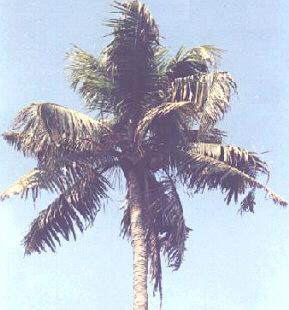
|
Negligence on the management aspects aggravates the malady. Efficient management
of palms suspected to be affected by coconut root (wilt) disease demands control
of all pests and diseases and imparting natural resistance and health to the palms
through proper manuring and agronomic practices. A package of management practices
for the effective management of root (wilt) disease is given below:
-
Rogue out palms that are affected severely by root (wilt) and yield less than 10
nuts / palm / year and those, which have contracted the disease before flowering.
Replant with disease tolerant material / high yielding hybrids (Chandrasankara).
-
Apply fertilizers for coconut palms as follows,
|
|
N
|
P2O5
|
K2O
|
|
palm/year
|
|
Average management
|
0.34 kg
|
0.17 kg
|
0.68 kg
|
|
Good management
|
0.5 kg
|
0.32 kg
|
1.2 kg
|
-
In addition to the above, apply 50 kg cattle manure or green manure and 1 kg of
lime / palm / year. Magnesium may be supplied @ 500 g MgO per palm per year in the
Onattukara region (sandy soil) and 100 g MgO in the remaining areas. The cheapest
source of MgO is magnesite (MgCO3). The magnesium in magnesite is acid
soluble. Hence it may be preferred in acid soils. Magnesium sulphate is the most
common source of MgO.
-
Growing green manure crops like sunn hemp, sesbania, cowpea and calapagonium in
the coconut basin and their incorporation in situ is beneficial as the
practice reduces the intensity of the root (wilt) and increases the nut yield. The
ideal green manure crops for the sandy and alluvial soils are cowpea and sesbania,
respectively.
-
Under rainfed conditions, apply fertilizers in two splits, 1/3rd at the
time of early southwest monsoon and 2/3rd before the northeast monsoon.
Under irrigated conditions apply fertilizers in three equal splits (April-May, August-September
and December-January).
-
Apply fertilizers and manures in 10 cm deep circular basins at a radius of 2 m from
the bole of the palm.
-
When the crop is grown under the bund and channel system, desilt the channel and
strengthen the bunds during summer months.
-
Follow strictly all the prescribed prophylactic measures against leaf rot disease,
red palm weevil, rhinoceros beetle etc. so as to ensure that the palms are not debilitated.
To maintain the productivity of the palms, prophylactic measures are of great importance.
Diseases Menu
Stem bleeding
Symptoms:
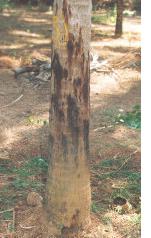
|
Exudation of the reddish brown liquid through the growth cracks mostly at the basal
part of the trunk and bleeding patches higher up in the trunk are characteristic
symptoms. One or more lesions, lying close by, may coalesce to form large patches.
The liquid that oozes out dries up and turns black. The tissues beneath the bleeding
points decay and become yellowish. The lesions spread upwards as the disease progresses.
In advanced stages, the leaf size reduces leading to reduction in crown size. The
rate of leaf production slows down. The production of bunches is affected and nut
shedding takes place. The trunk gradually tapers towards the apex. The progress
of the disease is faster during July to November.
Causal organism:
The fungus, Thielaviopsis paradoxa is the causal agent. Growth cracks on
the trunk, severe summer followed by heavy down pour, water stagnation, imbalance
in nutrition, excess salinity and stress can act as predisposing / aggravating factors.
|
Management:
-
Chisel out completely the affected tissues and paint the wound with
Bordeaux paste.Apply coal tar after 1-2 days.
-
Destroy the chiseled materials by burning. Avoid any mechanical injury to trunk.
-
Apply neem cake @ 5 kg per palm in the basin along with other organics.
-
Apply hexaconazole @ 25 ml in 250 litre of water as soil drenching once in four months.
-
.
Swabbing the lesions on the trunk with a paste of Trichoderma viridae talc based
formulation (100 g /100ml) along with application of lime or dolomite @ 1 kg /palm
during April-May and application of neem cake @ 5 kg /palm + organic manure enriched
with (1%) during September- October.
Diseases Menu
Bud rot
|
This disease was reported as early as 1913 by Fletcher, Govt. Entomologist of Coimbatore.
The causal organism was reported as Phytophthora palmivora (See image) by Shaw &
Sundararaman 1914. Disease spread slowly, though persistently, by means of tappers,
rhinoceros beetle and human agencies.
Symptoms
Palms of all age are liable to be attacked but normally young palms are more susceptible,
particularly during monsoon when the temperature is low and humidity is very high.
In seedlings, the spear leaf turns pale and comes off with a gentle pull. In adult
palms, the first visible symptom is the colour change of the spear, which becomes
pale and breaks at the base and hangs down. The tender leaf base and soft tissues
of the crown rot into a slimy mass of decayed material emitting a foul smell. The
rotting slowly progresses downwards, finally affecting the meristem and killing
the palms. This is accompanied by drooping of successive leaves. Even then, nuts
that are retained on the palm may grow to maturity. The disease proves fatal if
not checked at the early stages, before damage of the bud.
Management:
-
In early stages of the disease (when the heartleaf starts withering) cut and remove
all affected tissues of the crown. Apply Bordeaux paste and protect it from rain
till normal shoot emerges.
-
Burn all disease-affected tissues removed from the palm.
|
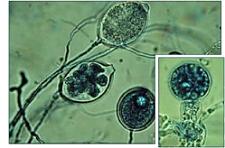
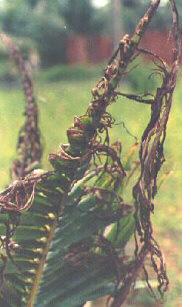
|
-
Spray 1% Bordeaux mixture on spindle leaves and crown of disease affected as well
as neighbouring palms, as a prophylactic measure. Palms that are sensitive to copper
containing fungicides can be protected by mancozeb. Small, perforated sachets containing
2 g of mancozeb may be tied to the top of leaf axil. When it rains, a small quantity
of the fungicide is released from the sachets to the leaf base, thus protecting
the palm.
-
Adopt control measures for rhinoceros beetle.
-
Provide adequate drainage in gardens.
-
Adopt proper spacing and avoid over crowding in bud rot prone gardens.
Diseases Menu
Mahali
Shedding of female flowers (buttons) and immature nuts occur in coconut due to various
reasons. The problem was reported in 1922 from Perumbilav and Chalissery areas of
Palakkad district of Kerala. Since it resembled the mahali disease of arecanut in
several respects, it was called as mahali disease. The disease is caused by Phytophthora
spp.
Symptoms:
Shedding of female flowers and immature nuts are the common symptoms of the disease.
Lesions appear on the young fruits or buttons near the stalk, which later lead to
the decay of the underlying tissues and endosperm. Newly fallen nuts show a whitish
growth of the fungus over the brown patches. This growth consists of the mycelium
and sporangia of the causal fungus.
Management:
Spray 1% Bordeaux mixture or copper oxychloride preparation (0.2%) on the crown
of palms, once before the monsoon and once or twice later on at intervals of 40
days.
Diseases Menu
Leaf rot
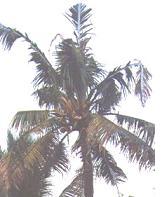
|
It is a common observation that leaf rot is often super-imposed on root (wilt) affected
coconut palms. Leaf rot, in fact, worsens the condition of the root (wilt) affected
palm very seriously.
Symptoms:
The first symptom is the appearance of water-soaked brown lesions in the spear leave
of root (wilt) affected palms. Gradually these spots enlarge and coalesce resulting
in extensive rotting. As the leaf unfurls, the rotten portions of the lamina dry
and get blown off in wind, giving a 'fan' shape to the leaves. Some times, the symptom
becomes very acute and the spear fails to unfurl.
|
|
This disease is a fungal complex initiated predominantly by Colletotrichum gloeosporioides,
Exserohilum rostratum (See image) and Fusarium spp .
|

|
Management:
-
Remove the rotten portions from the spear and the two adjacent leaves.
-
Pour 300 ml of fungicidal solution at the base of the spear. This can be prepared
by mixing hexaconazole 5EC 2 ml or mancozeb 3 g in 300 ml water.
-
Treat the top two leaf axils with insecticide preparation. This can be prepared
by mixing cartap hydrochloride 20 g with 200 g sand.
-
Spray crowns and leaves with 1% Bordeaux mixture or 0.2% copper oxychloride formulations
or 0.3% mancozeb in January, April-May and September. While spraying, care has to
be taken to spray the spindle leaf
-
After crown cleaning, (removal and destruction of affected parts) in
coconut palms pour 300 ml of any of the following bio- control agent
at the base of the spear leaves twice a year
(April-May and September-October)
-
Pseudomonas fluorescence (20g/l)
-
PGPRmix 11 (20 g/l)
Diseases Menu
Grey blight
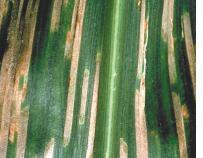
|
This is caused by the fungus Pestalotia palmarum .
Symptoms:
Symptoms appear in the mature leaves of the outer whorl as yellow specks encircled
by a greyish band which later becomes greyish white. The spots coalesce into irregular
necrotic patches causing extensive leaf blight. In advanced stages, the tips and
margins of the leaflets dry and shrivel giving a burnt appearance.
Management:
Remove severely affected older leaves and burn. Spray the trees with 1% Bordeaux
mixture or propiconazole 1 ml/l. .
|
Diseases Menu
Tanjore wilt (Basal Stem Rot)
|
Causal Organism : Ganoderma lucidum
Symptoms:
This disease is of recent occurrence in many parts of Kerala, especially in the
districts of Palakkad, Malappuram, Thrissur, Kollam, Thiruvananthapuram and Wayanad.
Middle aged palms were seen fatally affected. The characteristic symptom of the
disease is the rotting of the basal portion of the stem. The bark turns brittle
and often gets peeled off in flakes, leaving open cracks and crevices. The internal
tissues are discoloured and disintegrated, emitting a bad smell. Mild bleeding occurs
on the basal region. The tissues on the bleeding spots are soft to touch. Extensive
damage of the root system following root rotting has been observed. Ultimately the
palm dies off.
Management:
|
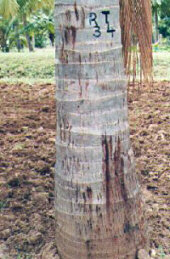
|
-
Apply organic manure @ 50 kg / palm.
-
Apply neem cake @ 5 kg / palm / year.
-
Reduce fertilizer application to one-fourth of the recommended dose.
-
Drench the basin with 40 litres of 1% Bordeaux mixture or tridemorph 0.1% or any
other copper fungicide to soak soil up to 15 cm depth at quarterly intervals.
-
Root feed with tridemorph 2 ml mixed with 100 ml water at quarterly intervals.
-
Avoid flood irrigation in order to prevent the possible spread of the pathogen through
soil.
-
Isolate the affected palm from the healthy ones by digging a trench of size 1 m
deep and 50 cm wide, 1.5 m away from the bole of the infected palm.
-
Avoid growing leguminous crops in and around the garden
Diseases Menu
Button shedding
The shedding of buttons in the coconut is attributed to the following reasons.
-
Pathological conditions
-
Attack of insect pests
-
Nutritional deficiencies
-
Soil and climatic variations
-
Defects in pollination and fertilization
-
Structural defects in the flower
-
Abortion of embryos
-
Limited capacity of the tree to bear fruits
-
Unfavourable conditions such as deficit of moisture, water logging and lack of aeration.
The causes of button shedding may be identified and appropriate remedial measures
adopted.
Diseases Menu
PLANT PROTECTION: PESTS
Rhinoceros beetle (Oryctes rhinoceros)

|
Occurrence and symptoms:
It is a very common destructive pest in coconut. The adult beetle bores through
the unopened fronds and spathes hampering the growth of the palm and predisposing
the palm to infestation by red palm weevil and bud rot. The attacked frond when
fully opened shows characteristic triangular cuts. The beetle attack is maximum
during summer months from March to June and minimum in September-October.
|
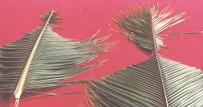
|
Management:
-
Provide field sanitation to prevent breeding of beetles.
-
Hook out the beetles from the attacked palms by using beetle hook.
-
The topmost three leaf axils around the spindle may be filled with any of the following
mixtures as a prophylactic measure:
-
Application of 250g neem cake or marotti (Hydnocarpus wightina) cake mixed
with equal volume of sand in the innermost 2-3 leaf axils. This treatment is to
be done twice, ie, during April-May before the onset of south-west monsoon and during
September-October after the south-west monsoon.
-
Naphthalene balls 12.0 g (approx. 4 nos.) in the innermost 2 leaf axils and covered
with fine sand, once in 45 days.
-
Incorporation of Clerodendron infortunatum @ 10 per cent w/w basis in the
cowdung pit and/or manure pits.
Crown cleaning followed by application of 20 g Cartap hydrochloride 4G or Fipronil 0.3G or
carbosulfan 6G mixed with 200 g sand in the innermost 2-3 laef axils.
This treatment has to be done thrice during January, May and September.
-
Release Baculovirus oryctes infected adults @ of 10-15 / ha to bring down
the pest population.
-
Inoculation of breeding sites with entomopathogenic fungus Metarrhizium anisopliae
(@ 5 x 1011 spores / m3) var major causes mortality to the
grubs.
Pests Menu
Red palm weevil (Rhyncophorus ferreugineus)
Occurrence and symptoms:

|
This weevil worst affects relatively young palms of age group between 5 to 10 years.
The mode of entry, nature of infestation and colonization of this pest go unnoticed,
defeating the normal pest management strategies. The diagnostic symptoms are the
presence of holes on the stem, oozing out of a viscous brown fluid and extrusion
of chewed up fibrous matter through the hole, longitudinal splitting of leaf base
and wilting of central shoot. Sometimes the gnawing sound produced by the feeding
grubs inside will also be audible.
|
|
Management:
-
Field sanitation should be given prime importance.
-
Avoid making steps or any other injury on the tree trunks to reduce the loci of
infestation.
-
Leaf axil filling as suggested in the case of rhinoceros beetle will be useful against
the red palm weevil also.
-
When green leaves are cut from the palms, stumps of not less than 120 cm may be
left on the trees in order to prevent successful inward movement of the grubs through
the cut end.
|
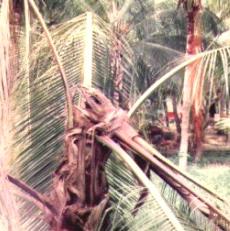
|
-
In attacked palms, observe for the bore-holes and seal them except the top most
one. Through the top most hole, pour 1% carbaryl or 0.5% trichlorphon suspension
@ one litre per palm, using a funnel.
-
When the pest infestation is through the crown, clean the crown and slowly pour
the insecticide suspension.
-
As an alternative, apply 1% DDVP as a curative measure.
-
Coconut log traps with fermenting toddy or pineapple or sugarcane activated with
yeast or molasses can be set in coconut plantation to attract and trap the free
floating population of red palm weevil. Incorporate any of the insecticide to each
trap to kill the weevils trapped.
-
Use of pheromone trap for attracting and killing adult weevils @ one trap per 2
ha.
Pests Menu
Leaf eating caterpillar (Opisina arenosella)
Occurrence and symptoms:
This is an endemic pest of coconut palm especially in the coastal tract of Kerala.
During epidemic of this pest, the palms often have a desolate look, the entire foliage
being eaten by the caterpillar. Severity of attack is seen during the months from
January to May. The caterpillar feeds on green matter from the lower leaf surface,
remaining within galleries of silk and frass.
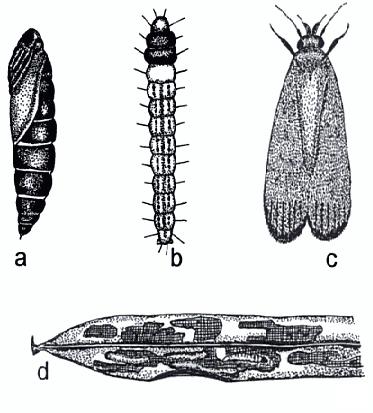
|
|
Lifecycle of Opisina Arenosella & infected leaf
|
Management:
-
As a prophylactic measure, the first affected leaves may be cut and burnt during
the beginning of the summer season.
-
Arrange for the release of larval / pupal parasitoids, Goniozus nephantidis, Elasmus
nephantidis (brown species) and Brachymeria nosatoi.
-
Trunk release of G.nephantidis @ 10 nos/plam (4 to 6 releases) is effective
for the management of leaf eating caterpillar.
-
When infestation is very severe and if the biocontrol is not likely to be effective,
spray the undersurface of the fronds with dichlorvos 0.05 per cent, malathion 0.1
per cent, quinalphos 0.05 per cent, or phosalone 0.07 per cent-
Flubendiamide 39.35% SC (0.2%), Chlorantraniliprole 18.5% SC (0.5%) or
Spinosad 45 SC (0.4 ml/l) are effective.
Note: Application of the insecticides
should be followed by liberation of larval and pupal parasites from the 21st
day.
Pests Menu
Coreid bug (Paradasynus rostratus)
Occurrence and symptoms:
The attacked buttons become deformed with characteristic crevices on the husk below
the perianth with gum exudations and the tender nuts become barren. The attacked
buttons do not develop resulting in immature nut fall.
Management:
Pesticide application is necessary if infection is severe. Spraying has to be done
three times a year. Apply 0.1% carbaryl on the newly opened inflorescence after
the receptive phase of the female flowers and spray the entire crown excluding the
leaves and older bunches. Destruction of pollinating insects can be avoided if spraying
is done in the afternoon hours.
Note: The insecticide may be applied
according to the severity of infection in a need-based manner.
Pests Menu
Cockchafer beetle (Leucopholis coneophora)
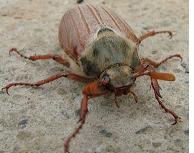
|
Occurrence and symptoms:
The white grubs are mostly found in sandy loam tracts of Kerala and Karnataka. It
damages the roots. In seedling, it tunnels into the bole and collar region. It has
an annual life cycle with a grub period of 8 months. Peak grub population is observed
from September to October. Adult beetles emerge out of the soil after pre-monsoon
showers in May-June during sunset hours. The infested palms turn pale yellow and
there will be considerable reduction in yield.
Management:
- Collection and destruction of adults
during the monsoon period from adjacent vegetation (in the evening).
- Plough or dig the infested soil synchronizing
with pre-monsoon showers.
- Drench the soil with chlorpyrifos 0.04
per cent suspension. The treatment should be given twice, first during April-May
after the receipt of pre-monsoon showers and second during the month of September.
|
Note: Note: wherever possible, light traps may be
set up to attract and trap adult beetles.
Pests Menu
Coconut eriophyid mite (Aceria [Eriophyes]
guerreronis)
Occurrence and symptoms:
|
The eriophyid mite, which was a minor pest of coconut in India, has become a major
pest on coconut recently. The mites are very minute in size and are not visible
by naked eye. It measures 200-250 microns in length and 20-30 microns in width.
The life cycle of this mite is completed in 10-12 days. It remains underneath the
perianth (cap) of the developing nuts (buttons) and causes injury by feeding on
the soft paranchymatic
|

|
|
tissues. Though the mites are microscopic, their damage is enormous and hundreds
of mites could be seen in each infested button and tender nut. The earliest symptom
on 2-3 month old buttons is pale yellow triangular patches seen below the perianth.
Later, these patches become brown. Severely affected buttons may fall. As the buttons
grow, brown patches lead to black necrotic lesions with longitudinal fissures on
the husk. Uneven growth results in distortion and stunting of nuts leading to reduction
in copra yield. In severe cases, the losses are compounded because the quality of
fibre is reduced and distorted nuts increase the labour requirement for dehusking.
The mites spread through wind and its multiplication is at a high rate. Though this
pest was noticed only in a limited area during 1998, it has become a major pest
of coconut in India.
|
Management:
-
Collect and destroy all the fallen buttons of the affected palm.
-
Apply 2% neem oil + garlic emulsion or commercial neem formulation of azadirachtin
0.004% (Neemazal T/S 1% @ 4 ml per litre of water) or micronized wettable sulphur
0.4% in the crown on young bunches. In large coconut plantations, dicofol 0.1% can
be applied after taking adequate precautions. However, spraying of dicofol should
be avoided in homesteads. When rocker sprayer is used 1.0 to 1.5 litre of spray
fluid per palm is required. If a hand sprayer is used, the spray solution required
may be about 500 to 750 ml. Spraying has to be done on second to seventh bunches
from top avoiding unpollinated inflorescence. Care should be taken to see that spray
fluid reaches the perianth region of third, fourth and fifth bunches since these
bunches harbour maximum number of mites. Three rounds of spraying are recommended
in a year viz., March-April before the onset of southwest monsoon, in August-September
during the dry spell between the southwest and northeast monsoons and in December-January
after the northeast monsoon so that all the emerging bunches in the vulnerable stage
receive one round of spraying. Rational rotation of the above pesticides may be
adopted to avoid chances of resistance.
Preparation of neem
oil + garlic emulsion (2%)
To prepare 10 litres of 2% neem oil + garlic emulsion, 200 ml neem oil, 200 g garlic
and 50 g ordinary bar soap are required. Slice the bar soap and dissolve in 500
ml lukewarm water. Grind 200 g of garlic and take the extract in 300 ml of water.
Pour the 500 ml soap solution in 200 ml neem oil slowly and stir vigorously to get
a good emulsion. Mix the garlic extract in the neem oil + soap emulsion. Dilute
this 1 litre stock solution by adding 9 litres of water to get 10 litres of 2 %
neem oil + garlic emulsion.
As per the recommendation of the National Level Steering Committee, a holistic approach
has to be adopted in the management of the coconut eriophyid mite. Hence, in addition
to the plant protection measures mentioned above, the following measures can be
adopted:
-
Improving nutrient status by applying organic manure at the rate of 50 kg and neem
cake 5 kg per palm per year. Also apply the recommended dose of fertilizers in two
split applications.
-
Growing compatible intercrops / mixed crops.
-
Providing adequate irrigation.
Pests Menu
Mealy bug (Pseudococcus sp.)
Occurrence and symptoms:

|
The mealy bugs are widely distributed and are usually implicated in various disease
conditions of coconut. During summer months, mealy bugs cause damage to spindle
leaves, spathes and the buttons. Mealy bugs infest the unopened heartleaf and inflorescence.
As a result, the leaves become highly stunted, suppressed, deformed and present
a crinkled appearance. It is often confused with the leaf rot symptoms. The affected
inflorescences are malformed and do not open. Even if they open, they do not bear
nuts. Button mealy bugs colonize under the perianth lobes of
|
|
tender nuts. Infested nuts harbouring gravid mealy bugs remain on the spadix, which
serve as inoculum for further spread.
|
Management:
Remove and destroy all dried up inflorescence and unproductive buttons. Apply non-residual
phosphatic insecticides like dimethoate 0.05% or quinalphos 0.05 % at the site of
infestation. Neem garlic emulsion 2% applied on infested bunches checks button mealy
bugs.
Pests Menu
Termites
Occurrence and symptoms:
It is estimated that nearly 20% of the coconut seedlings are damaged by termites
particularly in laterite soil.
Management:
-
Adopt field sanitation by avoiding organic matter residues in nursery soil and covering
germinating nuts with a layer of river sand.
-
Drench the nursery with 0.05% chlorpyriphos twice at 20-25 days interval.
-
Swab the affected trunk with the same chemical.
Pests Menu
Rodents
Occurrence and symptoms:
|
Among the non-insect pests, rodents are the most important group causing severe
crop damage to coconut, and damage is estimated as 20 per cent of the total production
of nut in India. Rats damage tender nuts by forming characteristic holes. Shed nuts
can be seen at the base of the palm.
Management:
- Place wax blocks of 0.005% bromadiolone in coconut crown of the infested palms at
3 to 4 days interval till the bait is no more consumed.
|
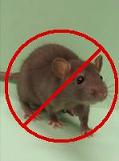
|
Pests Menu
|